It’s not often that creative pursuits require both left- and right-brain sensibilities, which is what makes the story of Haptic Lab so awe-inspiring. The Brooklyn-based design studio, beloved for its magnificently detailed quilts and fanciful kites, works with centuries-old craft methods while using of-the-moment technology to inform its designs.
We stopped by for a tour of Haptic Lab’s bustling creative space and to talk shop with founder Emily Fischer, who details the brand’s sentimental origin story, the handcrafted efforts behind each piece, and how she’s using Haptic Lab as a force of social good.
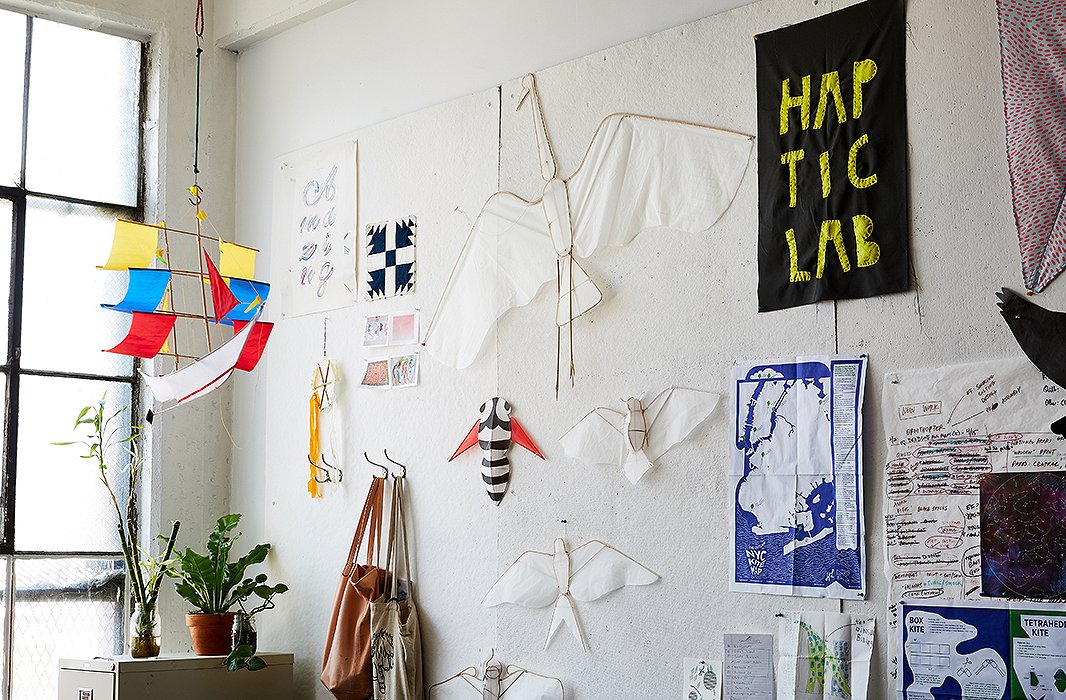
A few of Haptic Lab’s popular kites, fashioned in the shapes of sailing ships and animals, hang alongside patterned fabric swatches and printed maps in the studio.
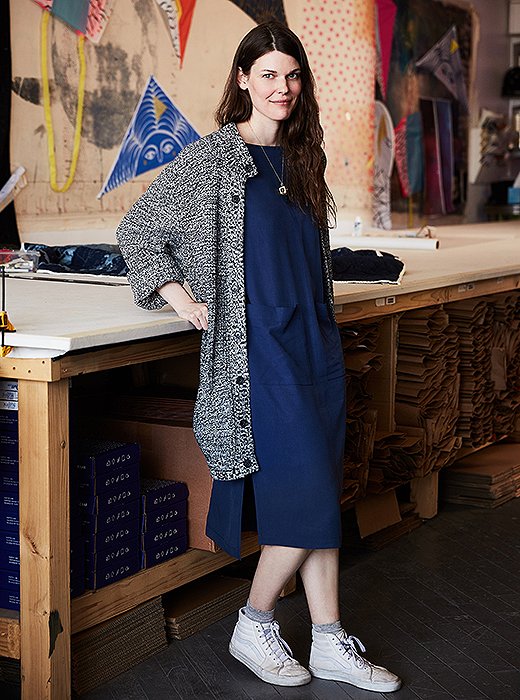
Founder Emily Fischer in Haptic Lab’s Brooklyn headquarters.
A Passion for Crafting
Emily did not set out to create a craft-based design business, though considering her background, you might say it was written in the stars. Crafting was a big part of her childhood in northern Wisconsin; it was something she did in her spare time, and her mom often participated in church craft sales. This interest stayed with her, and Emily continued to craft on the side while working as an architect.
Her tactile quilts, hand-embroidered with constellations and city street maps, began as a project to develop something that could be used as a way-finding tool for the visually impaired. The idea came from a personal place: Her mother had begun losing her sight due to glaucoma, and Emily wished to create pieces that appealed to her sense of touch—or haptics. “As designers, we don’t always privilege the other senses. It’s always about something that looks cool. I’m trying to design things that feel cool,” Emily says. Kites tap into the same idea of extending the sense of touch, though up to the sky. “When you fly a kite, it’s like experiencing flight,” she says. “By holding the kite’s strings, you interpret and feel what the wind conditions are above you.”

As designers, we don’t always privilege the other senses. It’s always about something that looks cool. I’m trying to design things that feel cool.
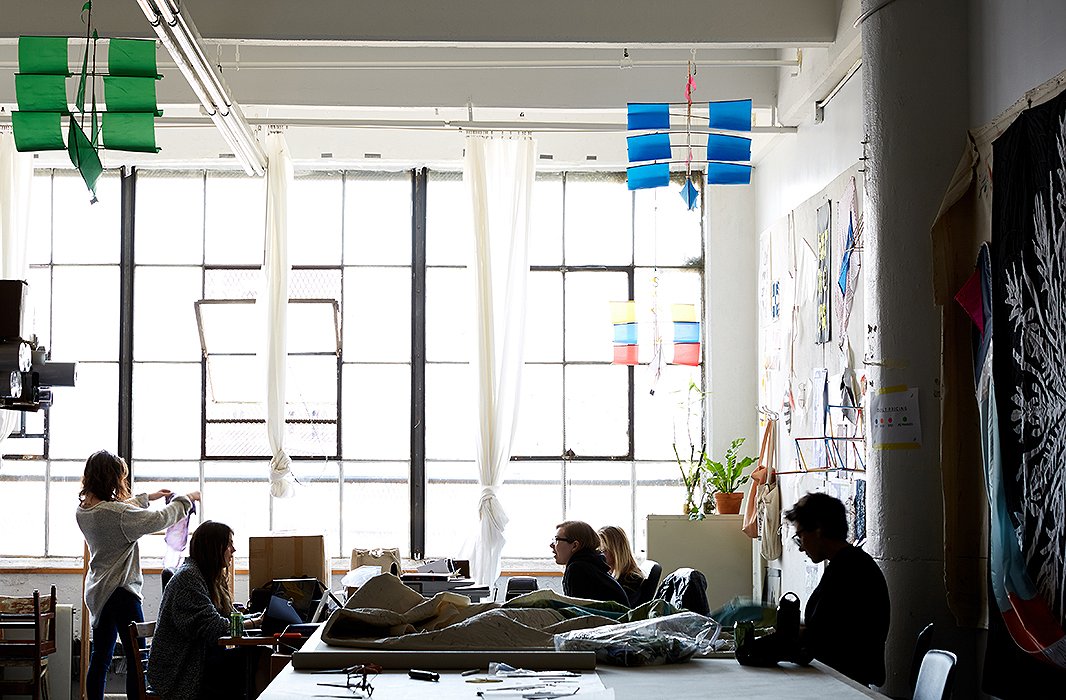
Hand-finishing quilts, assembling kites, working with international artisans, dreaming up new ideas: The small staff in Haptic Lab’s studio does a little bit of everything.
Building the Brand
After being laid off at the height of the economic downturn, Emily threw herself into quilt- and kite-making, posting her pieces online and entering design contests. Her creations soon attracted a following—and though she admits it wasn’t a smooth or easy transition, Haptic Lab was born.
Emily now operates the company out of a Brooklyn studio with a small, close-knit team of two full-time staffers and a handful of part-timers, many of whom have been working together for years. Emily says the team takes after that same left-brain, right-brain sensibility she honed as an architect and that everyone knows how to do a bit of everything. “The wholesale accounts manager knows how to embroider and can jump on and help when we’re fulfilling holiday orders,” Emily says. “That’s one of the reasons people enjoy working at the studio. Because you’re not stuck in the drudgery of one task. Everyone is making big contributions.”

The Haptic Lab team uses a large pinboard wall to brainstorm ideas and projects in development.
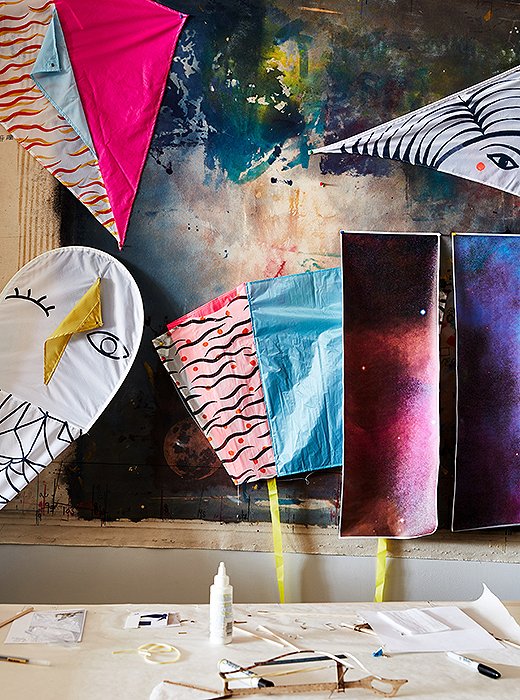
The Diamond, Delta, Pocket, and Comet kites give the kite-assembling station a bright and peppy backdrop.

Though Haptic Lab’s designs rely on technology, they’re all crafted by hand, many using everyday tools such as scissors and pliers. “Something that starts out on the computer never stays on the computer that long,” Emily says.
Bringing the Designs to Life
The production process sends each kite and quilt on a journey. The initial designs are hand-drawn to scale in the Brooklyn studio, then sent out to talented artisans abroad—from China to Bali to India—for construction. The pieces are then shipped back and often finished in-house, with the small Haptic Lab team doing much of the hand-embroidery themselves. They complete all orders from their Brooklyn studio instead of using a fulfillment center, emphasizing the importance of retaining that human touch. “I’ve always wanted to maintain that, to have everything in-house,” Emily says. “When you build something from scratch, you take pride in it. I still get excited when I send something to someone in the mail.”

The Swallow kite rests on top of Haptic Lab’s signature Constellation quilt, one of the brand’s original designs.
![The blue color of the Constellation quilt is color-matched to the ceiling of Grand Central Terminal in New York. “I’m a transplant New Yorker who’s used to seeing things like stars and the Northern Lights,” Emily says. “Being in a place where that didn’t exist felt like I was losing my place in the world. [I was] homesick for the stars. The only place you can really see them is the painted ceiling in the train station. That is the most sublime and beautiful place in the city.”](https://okl.scene7.com/is/image/OKL/BLOG1_HAPTICLAB_052317?wid=520&op_sharpen=1)
The blue color of the Constellation quilt is color-matched to the ceiling of Grand Central Terminal in New York. “I’m a transplant New Yorker who’s used to seeing things like stars and the Northern Lights,” Emily says. “Being in a place where that didn’t exist felt like I was losing my place in the world. [I was] homesick for the stars. The only place you can really see them is the painted ceiling in the train station. That is the most sublime and beautiful place in the city.”
Craft Tradition Meets the Digital Age
What makes Haptic Lab unique is that its pieces are built through a marriage of opposites—combining craft techniques that are hundreds of years old with modern technology to create something that feels entirely new and different. Quilting, in particular, has a rich history; it dates back by some accounts to ancient Egypt, although it’s most commonly thought of as a distinctly American craft, developing in popularity as a pastime among women in the 18th century.
The modern spin comes in through open-source (or freely available) maps and other imagery, which the Haptic Lab team uses to accurately render cityscapes, constellations, and bodies of water—first translating them into hand-drawn designs, then finishing them with hand-embroidery.
Though these tools allow for innovation and for the Haptic Lab team to create pieces that feel truly special, Emily maintains that it’s important to stay grounded in the history of the craft. “I’m never just going to laser-cut something and call it done,” she explains. “Using digital tools is wonderful, but with the craft knowledge that’s been established through hundreds of years of making. There’s a creative sensibility where we’re trying to build upon ideas of place and space and adding a whimsy—creating something that’s beautiful and that will also stand up to time.”

There’s a creative sensibility where we’re trying to build upon ideas of place and space and adding a whimsy—creating something that’s beautiful and that will also stand up to time.
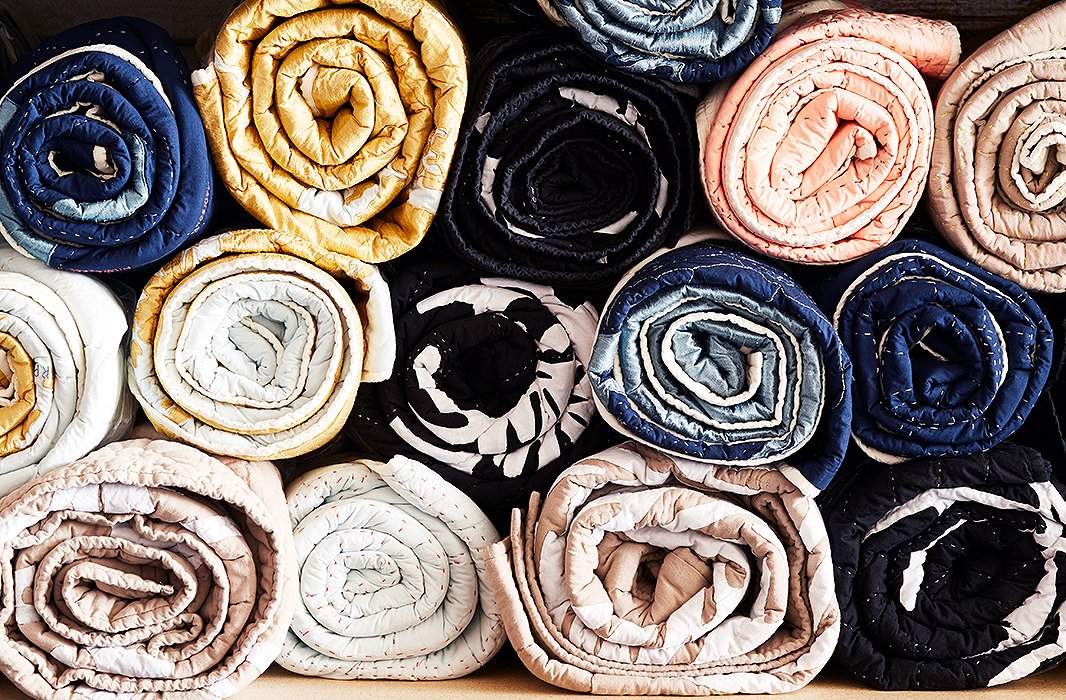
Finished quilts wait to be shipped off to new owners.
A Force for Good
Both fair-trade practices and environmental sustainability are at the heart of Haptic Lab’s company values, serving as a guiding force and influencing decisions at every step of the production process. Emily insists that sustainability shouldn’t touch just the supply chain but every other facet of the business as well—including how the customer interacts with the product. “The goal is not to make something that lasts just for an afternoon or for a season but to make objects that really become evergreen and a part of people’s lives,” she says.
A more immediate—and seriously impressive—measure they’ve taken to improve their ecological footprint involves the studio’s trash output, which has been reduced to one trash bag per week. “It can always be better,” Emily says of sustainability practices. “And that’s an important part, to never sit back and be like, Oh, we’re good. It’s never enough.”
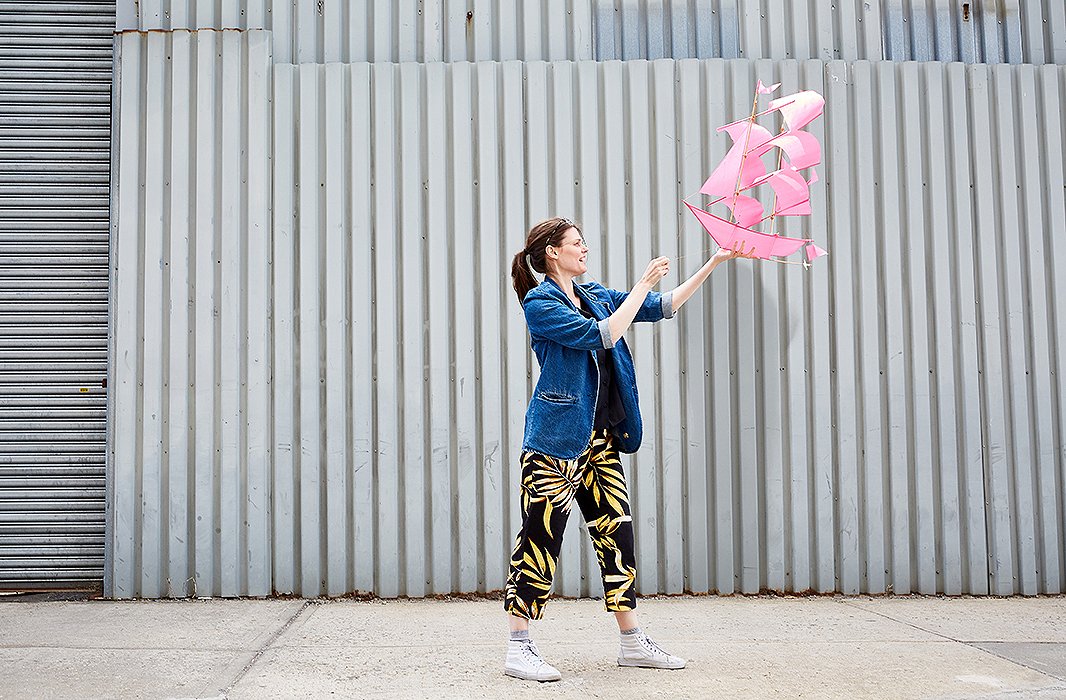
Emily prepares to send up the whimsical Sailing Ship kite, this version in a bright pink that will make an unexpected pop against the blue sky.

When you build something from scratch, you take pride in it. I still get excited when I send something to someone in the mail.
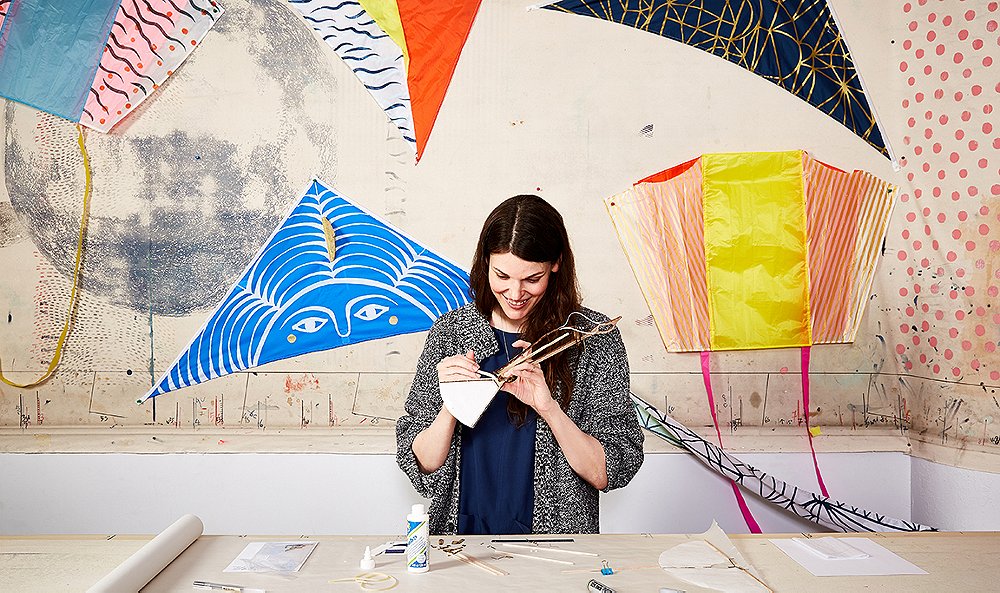
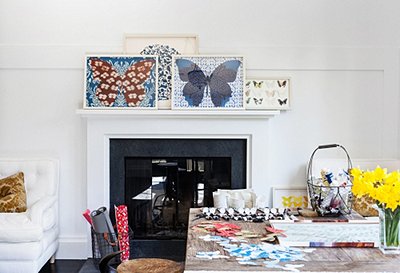
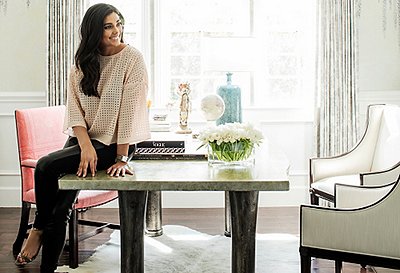
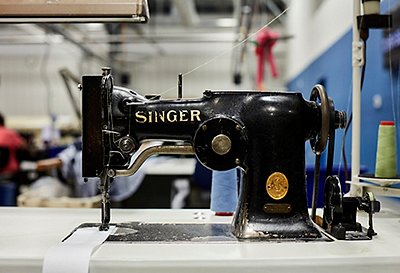
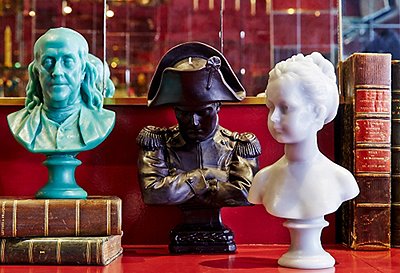
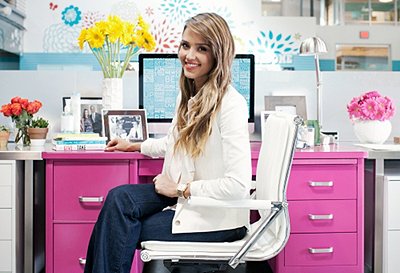
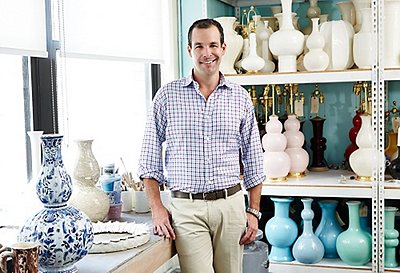
Join the Discussion